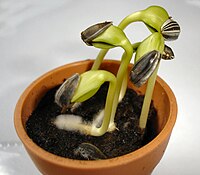
Photo from wikipedia
ABSTRACT: The use of herbicides for bean crop desiccation aiming seed production, is an alternative management because it allows harvesting when the seeds present high vigor, germination and dry mass,… Click to show full abstract
ABSTRACT: The use of herbicides for bean crop desiccation aiming seed production, is an alternative management because it allows harvesting when the seeds present high vigor, germination and dry mass, however this technique can cause damages to the seeds. The objective of this study was to evaluate the physiological quality of bean seeds, of the Carioca type, with the application of desiccant herbicides doses at different periods, aiming at the anticipation of the harvest. The bean plants, Pérola cultivar, were desiccated when the seeds had 42 and 30% water content, with ammonium glufosinate, saflufenacil and diquat at doses of 0, 50, 75 and 100% in relation to the recommended average dose for desiccation, respectively for each of the herbicides. The control treatment without desiccant application was harvested on the same date as desiccation. The additional treatment, also without desiccant application, was harvested only when the seeds had a water content of 18%. The variables analyzed were germination, first germination count, germination speed index, cold test, accelerated aging, seedling and radicle length, and dry mass. The herbicides applied in the first period (42% water), at the highest doses, impair the physiological quality of the seeds, and the seeds with water contents of 30 and 42%, without the use of desiccants, promote high vigor and germination. Satisfactory results were obtained when the saflufenacil herbicide was applied in period 2 (30% water), using 50% of the recommended average dose of this herbicide.
Journal Title: Planta Daninha
Year Published: 2019
Link to full text (if available)
Share on Social Media: Sign Up to like & get
recommendations!